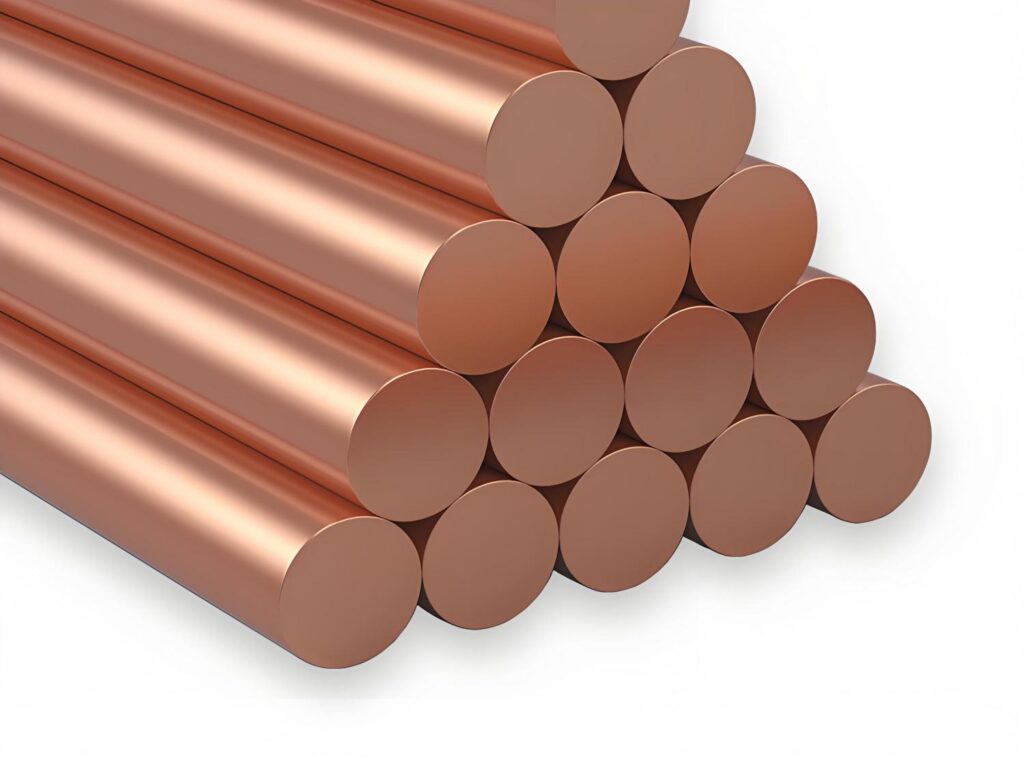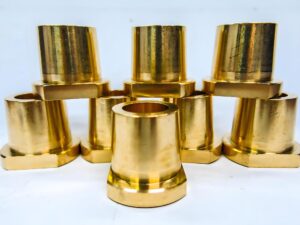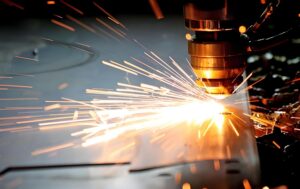What is Pure Copper?
Pure copper, often referred to as electrolytic copper or high-conductivity copper, is a metal that contains 99.9% or more copper content. Recognized for its bright reddish-orange appearance, pure copper is highly valued in industries due to its excellent thermal and electrical conductivity, malleability, and corrosion resistance.
Copper has been used by humans for thousands of years, and today it plays an integral role in a wide range of modern applications, from electronics to construction to precision machining. The majority of commercial copper is refined through electrolysis to ensure maximum purity, making it suitable for sensitive and high-performance applications.
While there are many copper alloys—such as brass (copper and zinc) and bronze (copper and tin)—pure copper stands out due to its unmatched conductivity and natural characteristics.
Chemical Composition of Pure Copper
Pure copper is composed almost entirely of the element copper (Cu), with trace impurities that are tightly controlled during the refining process. The standard grade of pure copper used in industrial applications is known as C11000 or Electrolytic Tough Pitch (ETP) copper.
Typical Composition:
- Copper (Cu): 99.9% minimum
- Oxygen (O): Up to 0.04% (in ETP copper)
- Other Elements: Less than 0.03% (including lead, sulfur, iron, nickel, etc.)
In highly pure applications such as semiconductors or vacuum tubes, oxygen-free high-conductivity (OFHC) copper is used, with a copper content of 99.99% or higher.
Maintaining such high purity levels is crucial in ensuring the performance of copper in electrical systems, heat exchangers, and precision mechanical components.
Properties of Pure Copper
Pure copper is admired for a combination of physical and mechanical properties that make it one of the most versatile metals available.
Physical Properties
Pure copper’s physical characteristics are responsible for its effectiveness in electrical and thermal systems.
- Electrical Conductivity: 100% IACS (International Annealed Copper Standard), making it the best conductor among non-precious metals.
- Thermal Conductivity: Approximately 401 W/mK at 20°C, ideal for heat sinks and exchangers.
- Density: 8.96 g/cm³
- Melting Point: 1,084°C (1,984°F)
- Color: Reddish-orange in natural form
- Non-magnetic: Does not interfere with electromagnetic systems
These characteristics make pure copper indispensable in electrical systems, electronics, HVAC systems, and renewable energy applications.
Mechanical Properties
Despite being a relatively soft metal, pure copper offers adequate strength and workability for many mechanical uses.
- Tensile Strength: 210-250 MPa (annealed); up to 370 MPa (cold-worked)
- Yield Strength: Approximately 33 MPa (annealed)
- Elongation at Break: 30-40%
- Hardness (Brinell): ~35 HB
- Modulus of Elasticity: 110-130 GPa
Pure copper can be easily formed, bent, drawn, or extruded, which makes it ideal for manufacturing fine wires, tubes, and complex machined components.
What Are Types of Pure Copper Grades?
Pure copper is available in various grades, each designed for specific applications based on purity and minor compositional differences. The Copper Development Association (CDA) assigns designations like C11000, C12000, and C12200 to categorize pure copper grades, each with unique characteristics tailored to industrial needs. Below is an overview of these key grades:
C11000 (Electrolytic Tough Pitch, ETP):
This is the most commonly used pure copper grade, with a minimum copper content of 99.9% and a small oxygen content (0.02–0.04%). C11000 is prized for its excellent electrical conductivity and affordability, making it ideal for electrical wiring, busbars, and architectural applications. Its slight oxygen content enhances weldability but may limit its use in high-vacuum environments.
C12000 (Deoxidized Low Phosphorus, DLP):
With a copper purity of 99.9%, C12000 contains a low level of phosphorus to reduce oxygen content, improving its resistance to hydrogen embrittlement. This grade is commonly used in plumbing tubes, heat exchangers, and other applications requiring good formability and weldability.
C12200 (Deoxidized High Phosphorus, DHP):
Also with 99.9% copper purity, C12200 has a higher phosphorus content than C12000, further enhancing its resistance to embrittlement and improving its suitability for welding and brazing. It is widely used in HVAC systems, refrigeration tubing, and plumbing fittings due to its excellent corrosion resistance and formability.
These grades allow industries to select the most suitable copper type for their specific requirements, balancing factors like conductivity, cost, and manufacturability.
What is Pure Copper Used For?

Pure copper’s unique combination of properties makes it a staple in numerous industries. Its applications span from high-tech electronics to traditional craftsmanship, showcasing its adaptability.
Electronics and Electrical Systems
The electrical industry is the largest consumer of pure copper, thanks to its unmatched conductivity. It is used in:
- Wiring and Cables: Most electrical wiring in homes, buildings, and vehicles is made from pure copper due to its efficiency in conducting electricity with minimal energy loss.
- Circuit Boards: Copper’s reliability ensures stable performance in printed circuit boards (PCBs) found in smartphones, computers, and other devices.
- Transformers and Motors: Copper windings in transformers and electric motors enhance energy efficiency and durability.
Industrial Applications
In industrial settings, pure copper is valued for its thermal properties and machinability.
- Heat Exchangers: Copper’s high thermal conductivity makes it ideal for heat exchangers in HVAC systems and industrial cooling units.
- Machining Components: Precision parts, such as fittings and valves, are often crafted from pure copper for its workability and corrosion resistance.
- Piping and Plumbing: Copper pipes are widely used in plumbing due to their durability and resistance to bacterial growth.
Architectural and Decorative Uses
Copper’s aesthetic appeal makes it a favorite in architecture and design.
- Roofing and Cladding: Copper’s ability to develop a patina gives buildings a distinctive, aged look, as seen in iconic structures like the Statue of Liberty.
- Sculptures and Art: Artists prize copper for its malleability and ability to hold intricate details in sculptures and decorative pieces.
Renewable Energy
The rise of renewable energy has increased demand for pure copper.
- Solar Panels: Copper is used in photovoltaic cells and wiring for solar energy systems.
- Wind Turbines: Copper components in generators and cabling ensure efficient energy transfer.
Advantages and Disadvantages of Pure Copper
Like any material, pure copper has its strengths and limitations, which determine its suitability for specific applications.
Advantages
- Superior Conductivity: Its excellent electrical and thermal conductivity makes it ideal for energy-efficient systems.
- Durability: Copper’s corrosion resistance ensures long-term performance, even in harsh environments.
- Recyclability: Copper is 100% recyclable without losing its properties, making it an environmentally friendly choice.
- Versatility: Its ability to be shaped, drawn, and machined allows for a wide range of applications.
Disadvantages
- Cost: Pure copper is more expensive than alternatives like aluminum, which can be a limiting factor in large-scale projects.
- Weight: Its high density makes it heavier than other conductive metals, which may be a drawback in weight-sensitive applications.
- Oxidation: While copper’s patina protects it, oxidation can affect its appearance in certain decorative uses if not properly maintained.
Precionn: Your Partner in Precision Copper Machining
For companies and engineers seeking reliable solutions in pure copper machining, Precionn offers world-class expertise. With a deep understanding of material properties and decades of experience in the machining industry, Precionn delivers high-quality, precision-machined copper components for electrical, industrial, and custom applications. Our independent online presence allows us to serve international clients with speed, precision, and confidence.
If you’re looking for a partner to handle your pure copper projects with care and competence, Precionn is ready to assist.
FAQ: Common Questions About Pure Copper
Yes, when referring to pure copper, it is a pure substance consisting almost entirely of the element copper (Cu), without intentionally alloying with other elements.
Most commercial copper wiring is made of pure copper, especially for electrical and electronic applications. C11000 or ETP copper is commonly used for wiring due to its excellent conductivity.
Yes, pure copper oxidizes when exposed to air, forming a layer of copper oxide that gradually turns green (patina). This layer actually protects the underlying metal from further corrosion.
Technically, copper does not rust like iron, because rust is a specific form of oxidation involving iron and oxygen. Copper corrodes, but this results in a different chemical process and usually forms a protective layer rather than a destructive one.
The value of pure copper fluctuates based on market conditions. As of recent industry pricing, pure copper trades between $8,000 and $10,000 per metric ton. Prices can vary depending on purity, form (sheet, wire, tube), and global demand.




